Open access
Some publishers (less than 5% and decreasing as of 2014) may charge a fee for an additional service[15] such as a free license on the publisher-authored copyrightable portions of the printed version of an article.[18][19] A publisher following this model is partially funded by subscriptions, and only provide open access for those individual articles for which the authors (or research sponsor) pay a publication fee.Since they do not charge either readers or authors directly, such publishers often require funding from external sources such as the sale of advertisements, academic institutions, learned societies, philanthropists or government grants.The re-use rights of libre OA are often specified by various specific Creative Commons licenses;[44] all of which require as a minimum attribution of authorship to the original authors.[65] Retention of copyright by authors can support academic freedoms by enabling greater control of the work (e.g. for image re-use) or licensing agreements (e.g. to allow dissemination by others).[91] Concern has been noted that increasing subscription journal prices will be mirrored by rising APCs, creating a barrier to less financially privileged authors.[citation needed] The main argument against requiring authors to pay a fee, is the risk to the peer review system, diminishing the overall quality of scientific journal publishing.[citation needed] A persistent concern surrounding preprints is that work may be at risk of being plagiarised or "scooped" – meaning that the same or similar research will be published by others without proper attribution to the original source – if publicly available but not yet associated with a stamp of approval from peer reviewers and traditional journals.[108] These concerns are often amplified as competition increases for academic jobs and funding, and perceived to be particularly problematic for early-career researchers and other higher-risk demographics within academia.[110] During this time, the same work will have been extensively discussed with external collaborators, presented at conferences, and been read by editors and reviewers in related areas of research.[citation needed] Preprints provide a time-stamp at the time of publication, which helps to establish the "priority of discovery" for scientific claims (Vale and Hyman 2016).Some publishers require an embargo period before deposition in public repositories,[112] arguing that immediate self-archiving risks loss of subscription income.These institutions' administrators, faculty and librarians, and staff support the international work of the Coalition's awareness-raising and advocacy for open access.The awareness raising activities of the AOASG include presentations, workshops, blogs, and a webinar series on open access issues.For example, the SciELO (Scientific Electronic Library Online),[157] is a comprehensive approach to full open access journal publishing, involving a number of Latin American countries.[26] In August 2013, a study done for the European Commission reported that 50% of a random sample of all articles published in 2011 as indexed by Scopus were freely accessible online by the end of 2012.[204] Open access initiatives like Plan S typically call on a broader adoption and implementation of the Leiden Manifesto[note 3] and the San Francisco Declaration on Research Assessment (DORA) alongside fundamental changes in the scholarly communication system.[212][218] Additionally, the rise of OA megajournals has made it viable for their peer review to focus solely on methodology and results interpretation whilst ignoring novelty.[227] Although commonly associated with OA publishing models, subscription journals are also at risk of similar lax quality control standards and poor editorial policies.[228][229][230] OA publishers therefore aim to ensure quality via auditing by registries such as DOAJ, OASPA and SciELO and comply to a standardised set of conditions.In 2012 Duncan Hull proposed the Open Access Irony award to publicly humiliate journals that publish these kinds of papers.These databases overlap, however each has different inclusion criteria, which typically include extensive vetting for journal publication practices, editorial boards and ethics statements.[243][244][245][173][246] Most subscription journals place restrictions on which version of the work may be shared and/or require an embargo period following the original date of publication.While these databases primarily select based on process and content quality, there has been concern that their commercial nature may skew their assessment criteria and representation of journals outside of Europe and North America.While welcomed by some members of the academic community, publishers argued that the suggested model is unrealistic due to the lack of crucial funding details.Furthermore, the council's recommendations raised concerns within the publishing industry regarding the potential implications, and they also emphasized the importance of research integrity and the need for member states to address predatory journals and paper mills.[281] In 2024, the government of Japan also announced a Green open access policy, requiring that government-funded research be made freely available on institutional preprint repositories from April 2025.[2][285] From March 2021, Google Scholar started tracking and indicating compliance with funders' open-access mandates, although it only checks whether items are free-to-read, rather than openly licensed.[286] Gender inequality favoring men can be found in many disciplines, including political science, economics and neurology, and critical care research."[289] "One of the great ironies of open access is that you grant authors around the world the ability to finally read the scientific literature that was completely closed off to them, but it ends up excluding them from publishing in the same journals" says Emilio Bruna, a scholar at the University of Florida in Gainesville.


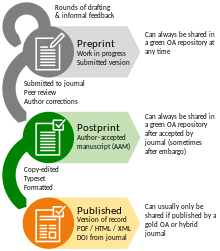
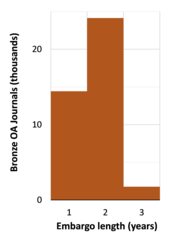
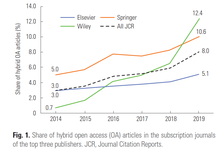
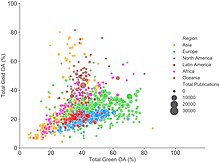


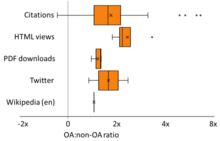

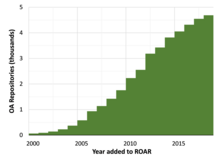
Open sourceOpen access (disambiguation)Public Library of SciencePhD Comicscopyrightableopen licensepeer reviewedacademic journalshave beenserials crisisnewspapersmagazinesfiction writingdemand elasticityHarry Potter and the Philosopher's StoneA Voyage to Lilliputemergency roomphysicianurushiolpaywalledprednisonediamond open accesselectronic publishingjournal articlesaccess tollspay-per-viewauthor feespeer-reviewedacademic journalconference papersthesesmonographsresearch reportsDirectory of Open Access JournalsPubMed CentralCreative Commonsarticle processing chargeSelf-archivingfree licensepostprintHybrid open-access journalsdouble dippingMephistophelianopen access mandatesadvertisementsacademic institutionslearned societiesphilanthropistsgovernment grantsimpact factorsShadow librarySci-Hub#ICanHazPDFGratis versus librefree content'gratis' and 'libre'Budapest Open Access InitiativeBethesda Statement on Open Access PublishingBerlin Declaration on Open Access to Knowledge in the Sciences and HumanitiesCreative Commons licensesattribution of authorshipopen-access mandatesdata miningbig dataeconomistsmachine learningcomputer scientistspatent analysisFAIR dataEuropean Commissionopen scienceopen researchPlan Stransfer of copyrightpublisherlicenseacademic freedomsElsevierBioMed CentralSubscribe to OpenAnnual ReviewspublisherssocietyHindawi Publishing CorporationFrontiers in...research grantAtmospheric Chemistry and PhysicsNature CommunicationsUbiquity PressMatthew effectless developed economiespeer reviewerspeer reviewbusiness modelssocietiesKnowledge UnlatchedFree Journal NetworkpreprintpublishedSHERPA/RoMEOdigital object identifierASAPbioElsevier journalsEmbargoeshumanitiessocial sciencessubscription revenueAcademic journal publishing reformInternetWorld Wide Websubscription business modelgratiscopyrightscientific journalprofessionalresearcherjournalistcivil servantmental health professionalsResearch fundingROARMAPDutch universitiesDAREnetNARCISlibrariansinterlibrary loan
